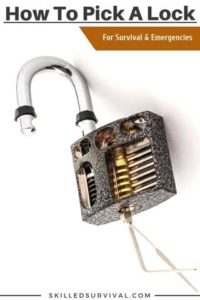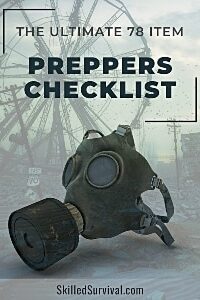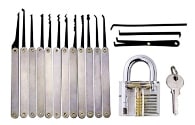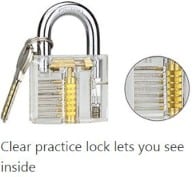
Which includes:
- Methods using bobby pins and credit cards—the kind of quick, on-the-fly solutions you can use when you’re really in a pinch.
- Conventional methods with picks—the tried-and-true techniques that have been used for generations by locksmiths and survivalists alike.
- Clever techniques using hammers and jacks—for when you need a little more force and ingenuity to get the job done.
Learning how to pick a lock is a valuable skill to have, even in everyday life. Whether you’re locked out or just want a handy skill in your back pocket, it pays to know.
But in an emergency, it’s an absolute game-changer.
3 Types Of Locks You Can Pick
Lock picking is an art as old as locks themselves. And over the centuries, locks have become sophisticated. But so have the methods of breaking into them.
Anyone with a paperclip can defeat a privacy pop lock on a bathroom door. But a modern deadbolt can prove a formidable challenge.
With such various lock types on the market, it’s worth looking at several.
The good news is while there are many different locks, some are more common than others. So, here are the most popular locks and how to pick them.
1. Pin Tumbler Locks
The pin tumbler lock is the most common today.
You’ll find them in key-based padlocks, standard exterior knob locks, AND Deadbolts. So, if you’re interested in gaining access to sheds, warehouses, and most homes, you’ll want to pick this type of lock.
↓ How Pin Tumbler Locks Work
2. Combination Locks
Combination locks are known for their use with gym lockers. They’re often built into school lockers.
You’ll also find them on old-style safes. So, if you lose the combination, you’ll want to learn how to “pick” it.
↓ How Does A Combination Lock Work?
3. Tubular Lock
You’ll find this type of lock on smaller containers such as file cabinets or RV compartments. They are unique in how they work. Thus, they take a special set of tools to pick them.
They use the same concept as pin and tumbler locks, but they orient the pins in a circular pattern.
↓ Demo Of a See-Through Tubular Lock

Want a free 78 item preppers checklist?
Enter your email below to instantly download this Complete Checklist PDF. No purchase necessary. 👇 👇9 Clever Ways To Bypass A Lock
All locks have the same goal. To secure stuff.
It could be behind a door, within a container, or the item itself (such as a bug-out bike or survival trailer). And each lock requires different “picking methods” to bypass.
So, let’s go over the most common ways to bypass locks.
1. How To Pick A House Lock With A Card
The first method of lock picking uses a thin plastic card. This method is best suited to simple spring latches.
These types of doors are commonly found in supply closets and offices.
Most people think that a credit card is best. But a thinner, more flexible plastic card is easier to use.
Gift cards, hotel key cards, and store loyalty cards are great.
There are three things to check before you try using a card to open a lock:
- NO DEADBOLT: If the door has a deadbolt, you won’t be able to open it with a credit card.
- NO HINGES: You need to be on the proper side of the door for it to work. If you can see the hinges, you’re not on the right side for a credit card to work.
- NO OBSTRUCTIONS: You need to be able to slip the credit card along the edge of the door. So, anything that obstructs your access to the latch area will be a problem.
Three simple steps are needed once you have the right card and verify this method is possible.
First, slip the card into the space between the door and the latch plate. It’s easiest to slip a corner first, then straighten the card until the entire edge is inserted into the gap.
Next, bend the card towards the doorknob. This will force the card to bend slightly around the corner and toward the latch.
Finally, press the card further into the gap and slowly wiggle it back and forth. This motion will walk the edge of the card back towards the latch and up the latch’s slanted face.
This forces the latch inwards and pops the door free!
↓ How To Pick A Lock With A Credit Card
2. How to Pick A Door Lock With Bobby Pins / Paperclips / Screwdriver
Many home interior locks are designed to provide privacy, not security. This includes bedroom and bathrooms. So, knowing how to open them is a must for most parents with small children.
These doors have a small hole in the center of the doorknob, which gives you access to the lock mechanism. While they usually come with a wire “key,” those are almost always missing when you need one.
Instead, insert a tiny screwdriver or a straightened paperclip into the hole.
A pressure switch or a small, straight-blade screwdriver slot will be at the back of the hole.
The pressure switch is more common and can be opened by merely pressing on the switch until it pops.
The screwdriver-style locks are less common. But they only require a slight twist to open the latch.
↓ How To Pick Locks With A Paper Clip
Picking A Tumbler Lock
With a more secure door or one featuring a deadbolt, you must learn some advanced lock-picking techniques. Rather than defeating the latch, these methods work on the lock mechanism itself.
These locks work on a rotating cylinder with several spring-loaded pins. These pins must be individually lifted to the right height to allow the cylinder to turn the lock.
They take practice and some specialized tools. But it can be mastered quickly with a practice lock and pick set.
Lock Picking Tool Sets
A good lockpicking toolset doesn’t need to cost you an arm and a leg.
You can get a set at a surprisingly affordable price, And they can last a lifetime, making them a great investment.
I recommend you buy several sets, one for each of your vehicles; that way, you’ll never be without lockpicking gear.
You should get The Ultimate Access Lockpick Set.
This reasonably priced set of high-quality picks can open nearly any lock worldwide. You’ll also get a see-through practice padlock.
So you can bypass the learning curve that most newbies get stuck on and rocket your skills to the master level quickly.
Another option is to invest in a pickgun.
↓ How To Open Locks With A Lock Pick Gun
3. The Scrubbing/Raking Method
The how-to-pick a door lock method is called “scrubbing.” It’s a fast and dirty way to do the job on most locks.
It’s an art – you must develop a feel for the technique and how it works with each lock.
Despite the reliance on feel, the steps are largely the same.
- First, insert the tension wrench into the bottom of the keyhole. Next, try applying pressure. The tension wrench should rotate the lock cylinder slightly. Don’t press too hard, or you risk binding up the lock cylinder and making it more difficult to pick.
- Next, try inserting the pick rake at the top of the keyhole and slide it to the back of the lock.
- Lift the rake upwards into the pins and draw it forward. As the pick slides across each pin, it will lift the pins upward into position. Hopefully, the lip of the shear line will slightly turn the cylinder and catch to keep them in place.
- Repeat steps 2-3 until all the pins are in position and the cylinder turns further.
- Gently apply the proper tension to the lock cylinder and open the door!
↓ How To Rack Your First Lock
4. The Pin-by-Pin Method
Scrubbing is a good first choice, but it doesn’t always work. When the lock requires more finesse, turn to the Pin-By-Pin method.
This is a good way to improve your lock-picking skills.
It allows you to feel the delicate movements inside a lock cylinder as the pins slide into place.
Pin-by-pin picking (or single-pin picking) is similar to scrubbing. But instead of blindly pressing up on all the pins, you probe each pin individually.
You meticulously search for the pin that’s currently binding up.
- Insert the tension wrench into the bottom of the keyhole and apply some torque. The tension wrench should rotate in the lock cylinder. Don’t press too hard. Otherwise, you risk binding up the lock cylinder, making it more difficult to pick.
- Insert the single hook pick into the top of the keyhole and slide it to the back of the lock.
- Lift the pick upwards and test each pin individually. Do this until you find the one that’s binding the cylinder.
- Press the binding pin upwards until the cylinder shifts slightly. This is done mainly by feel because the torsion wrench shift will be tiny.
- Repeat steps 2-4 until all driver pins are in place and the cylinder turns further.
- Turn the lock cylinder with gentle pressure on the tension wrench and open the door!
Watch the following lock pickers instructional video:
↓ How To Easily Pick A Lock (Explained)
Here’s a video showing how to pick a lock with a hairpin.
So yes, it’s possible. But if you’re going to become a master at picking locks, hairpins are not ideal.
↓ Picking A Lock With A Hairpin
5. How To Pick A Combination Lock
You’re not technically “picking” this lock; it’s more accurate to say you’re “cracking the code.” In this technique, you will manipulate the lock to determine the combination code.
The combination lock comprises two basic components: the dial and the shackle.
The dial is the bulk of the lock and is the part that spins. The shackle is the bent metal locked inside the main compartment.
Watch the following video to learn how to pick a combination lock:
↓ Crack A Masterlock Combination Lock In 60 Seconds!
6. How To Pick A Tubular Lock
Now, we come to special locks on small filing cabinets and motor home storage boxes.
Tubular locks have a set of pins and a tumbler. But they’re set up in a circular pattern.
You’ll need a special tool to map these pins and pick them.
Tubular locks are nearly impossible to pick without the right set of tools. However, if you have the proper tools, you’ll easily map the pins and pick this type of lock.
Master this technique by watching the following video:
↓ A Beginner’s Guide To Tubular Lock Picking
How To Pick A Lock Without Tools
There are many ways to get around a lock – even without picking tools. Sometimes, you must “think outside the box” to get around a locked door.
So before you spend lots of time and energy lock picking, make sure it’s necessary.
7. Remove the Hinges
First, check the doorway for exposed hinges.
Most manufacturers install door hinges on the same side as the lock mechanism. But sometimes contractors don’t pay attention. Or the door has to swing outwards for safety reasons.
If the hinges are on your side of the door, it’s worth trying to remove the hinge pins.
Start by checking to see if the hinge pins are screwed in or simple straight pins.
If the pins are screwed in, you may need an Allen key or specialized screwdriver bit to remove them.
If they’re simple straight pins, you may be able to insert a flat screwdriver under the head of the pin. Try prying upwards slowly. You can often persuade stuck pins with a bit of spray lube.
So try tapping gently upwards on the bottom of the pin with a pointed tool such as a Phillips screwdriver.
Once the pins start to move, be sure to remove the bottom ones first. This will help prevent the door from binding the lower hinges.
After all the pins are removed, you should be able to swing the door open from the hinge side and remove it from the frame.
8. Destroy the Lock
In the movies, shooting a door’s lockout looks easy. While possible, shooting at a metal doorknob is just asking for a dangerous ricochet.
Instead, take a large hammer and smash it down on the handle until it breaks free.
Without a handle, you’ll have access to the inside of the lock mechanism.
If so, pull the latch back enough to open the door.
9. Bend The Door Frame
If all else fails, you can always grab your vehicle jack and try bending the frame out of the way! This is a method that law enforcement uses to open stubborn doorways.
A high-lift or hydraulic bottle jack is usually best for bending the door frame.
These high-capacity jacks allow you to put a lot of force on the door frame at specific points.
First, place the jack sideways from the hinge side to the latch. You may need to add blocks if the jack is too small. The blocks will help to “raise” the jack.
You need the jack to press outwards on the door frame. If the frame is wood or sheet metal (instead of solid steel or concrete), it will bow outwards under pressure.
Once you have enough of a gap, you should be able to pop the latch free and open the door.
5 Reasons You Should Learn How To Pick A Lock
Since the dawn of time, thieves have stolen what’s not theirs. And the only way to combat this is to use tools to deter their behavior.
Locks are an essential tool for protecting YOUR stuff. Locks, safes, diversion safes, alarm systems, and in extreme cases, booby traps. But while locks are better than nothing, they’re not foolproof!
With the right skills, locks CAN be picked.
Now, picking a lock does sound nefarious. And any thief with the right skill set (and motivation) CAN bypass most locks. And their reasons for picking are simple – they covet. It’s not rocket science.
But today, dear reader, I will assume YOU are NOT a thief. Well, then, why should anyone else want to pick a lock?
Here are a few examples:
1. Lost Keys
Standard padlocks require a key. And what’s one of the most common items to lose?
Your keys…
So, what are your options if you lose your key? Well – you can either invest in a large set of bolt cutters, call an expensive locksmith, or pick your own lock!
Picking a padlock is the cost-effective way to be re-acquainted with your valuables…
2. Escape From Captivity
Or here’s an even better reason – escape. Let’s say you were taken hostage and locked inside a secure room…
If you have the skills and basic tools, you may be able to escape. And while this scenario is unlikely,
I believe it’s one of the most resilient skills anyone can learn.
With this skill, you can quickly turn yourself from a helpless victim to a hero.
3. Feed Your Family In An Emergency
Let’s say your local area becomes lawless. A free-for-all zone.
- Maybe it’s a local emergency (like the aftermath of a devastating hurricane)
- Or a global economic collapse that’s gotten out of hand.
- Or perhaps it’s the aftermath of a nuclear attack.
The exact reason doesn’t matter.
If you are starving and society is no longer functioning, you need calories. In such a situation, breaking in might be an acceptable moral decision.
Raiding the pantry of an abandoned home is moral in dire circumstances…
4. Breaking Into A Building To Avoid Severe Weather
This scenario is similar, but a storm, tornado, or blizzard is creating the urgency.
Regarding survival, I’d rather break into a warehouse than get hit in the face with flying debris… Or die due to hypothermia.
5. Start A Small Business Venture
Finally, if you become a locksmith, you can turn these skills into a profitable side hustle.
Being a locksmith is a nice way to earn a living. Why? Because people don’t call you unless it’s serious. So they’re willing to pay well for services rendered.
You have leverage – a powerful force in a business transaction. This is to say it has good profit margins!
These are just a few examples of how opening a lock without a key makes you a hero instead of a villain.

Want a free 78 item preppers checklist?
Enter your email below to instantly download this Complete Checklist PDF. No purchase necessary. 👇 👇Action Plan
Picking locks is a great survival skill to have in your back pocket. They don’t require much in the way of tools but require dedicated practice. Make a game of it.
Try picking your own door locks and your friends (if they’ll let you). So put the time in and learn how to pick locks and open doors.
You may be able to get out of a sticky situation or into a locked cupboard full of snacks!

- Invest in professional locking-picking tools
- Watch all the videos in this article
- Practice, practice, practice.
That’s it. Just make sure you only use this newfound power for good. Don’t be evil!

Prepare, Adapt & Overcome,
P.s. - I just found out 2 out of 3 Americans don’t feel prepared for a 3 day disaster!!!
I guess this goes to show how modern society continues to embrace ‘living a fragile life.’ What’s crazy is… it’s so easy to fix.
To make sure YOU have the basics, watch our FREE training on “10 Simple Steps To Basic Preparedness” that shows you HOW.
Nothing crazy here… this isn’t doomsday prepping... just the basics every responsible adult should have before a disaster strikes.Why You Can Trust Skilled Survival...
Go here now to review a full breakdown of:
- Who We Are
- Our Credentials
- Our Mission
- & Product Recommendations...
Here are a few highlights of our teams credentials & certifications:
- Certified Member of a Mountain Search & Rescue Organization
- Plant Emergency & Safety Leader for a Major Food Manufacturer
- Member of the 10TH Mountain Division Hut Association
- Certifications: Avalanche 1, WFR, CPR
- Official Gear Tester for Numerous Outdoor Gear Companies
- Countless Multiday Backpacking trips into Remote Wilderness
- Bachelor's Degree In Mechanical Engineering
- Bachelor's Degree In Civil Engineering
- Bachelor's Degree In Biomedical Engineering
"It takes 20 years to build a reputation and five minutes to ruin it." - Warren Buffett
We're fully aware that trust is NOT something you GET but is EARNED.
And we'll continue to earn YOUR trust through our forthright and honest approach with each new Blog Post, Guide & Product we create...
P.s - I just took this FREE 60-second 'Readiness Score Quiz'👇
AND... I've still got a few gaps in my preps...🤔 But at least, I'm not part of 'The Fragile Masses'. 👍 Find out where YOU stand by answering a few questions...

Recommended Reading
Survival Pack: How To Build One NOW (before SHTF)
A complete list of critical items that need to be in your survival pack before heading out into the wilderness.
Survival Packing List: Best For An Evacuation
Everyone needs a survival packing list to organize their escape. That way you won't regret leaving something critical behind.
Wild Edible Plants: The 13 Best Ones ANYONE Can Find
Discover the best wild edible plants you can find and eat nearly anywere. Knowing and identifying these wild edibles could save your life.
How To Make Catfish Bait: My Grandpa’s Ultimate Recipe
I want to share with you what I consider the best catfish bait recipe. Here's how to make stink bait that will get the catfish to bite.
Paracord Projects: 17 Useful Survival Tools You Can Make Today
I share the best paracord projects that are both fun and useful. By doing these crafts you'll always have lifesaving cordage on hand.
Survival Skills: The Ones Everyone Should Master
The best survival skills will keep you alive even in extreme conditions. 1. Water 2. Shelters 3. Fire 4. Navigation 5. Signaling 6. Medical







